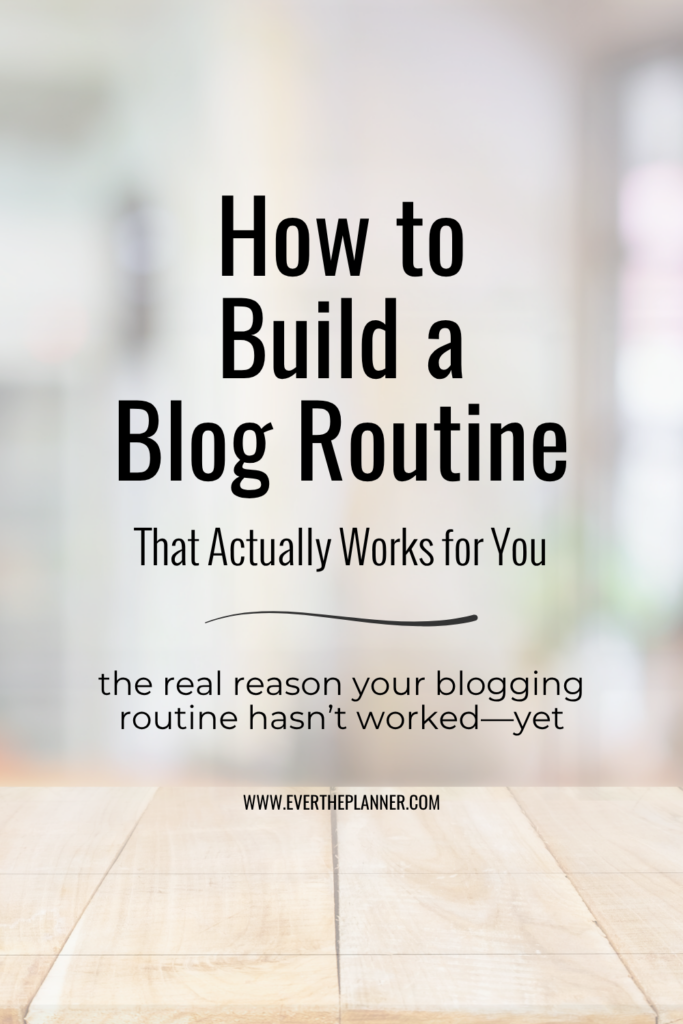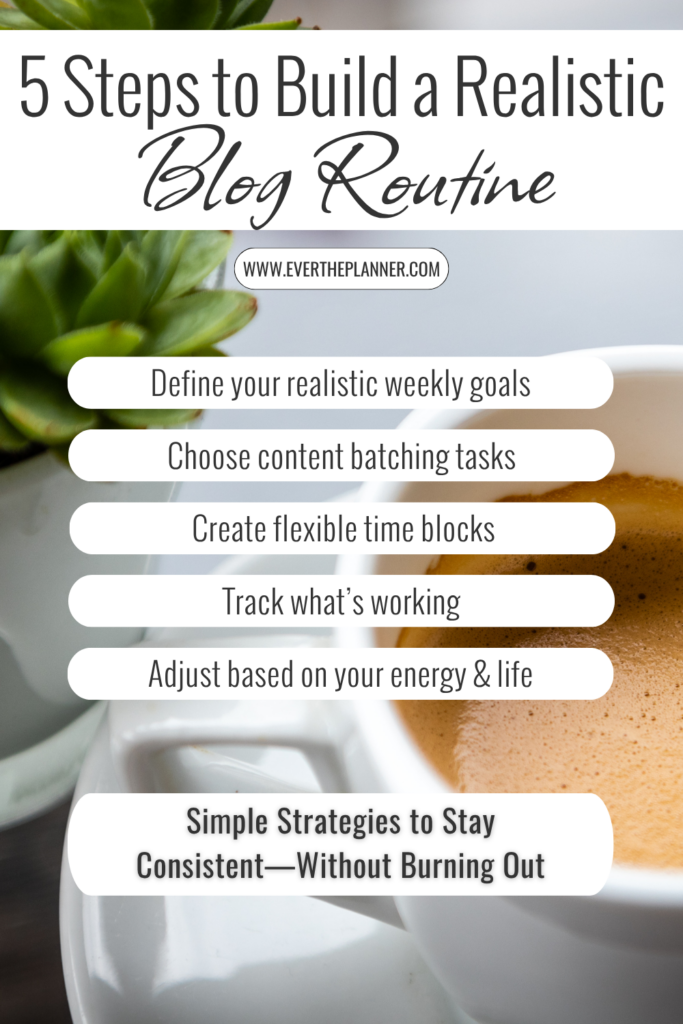How to Build a Blog Routine That Actually Works for You

When you picture building a consistent blog routine, it’s easy to assume it needs to be intense: early mornings, hours of focused work, perfectly timed posts, and a color-coded planner that never gets behind.
But if you’ve got a full plate—whether it’s a day job, kids, caregiving, or just being human—that version of blogging might feel impossible. And honestly? That’s okay.
You don’t need five hours a day to build a blog that works. You don’t even need a full hour.
What helps most is having a routine that fits your actual life—not the one you wish you had on paper.
In this post, I’ll walk you through how to build a blog routine that helps you stay consistent, make progress, and feel good about the way you’re showing up—even if you’re working in short bursts or squeezed-in moments. Because you don’t have to do it all to do it well.
TL;DR:
You don’t need hours of free time to build a successful blog—you just need a routine that fits your life. In this post, you’ll learn how to create a blog rhythm that works whether you have five hours a week or just 30 minutes a day. It’s all about small, repeatable actions that help you stay consistent without burning out.
Build a Blog Routine Around Your Real Life
If you’ve ever tried to follow a blogging routine you found online—only to crash and burn a few days in—well, me too.
Most of those plans are built around ideal circumstances: unlimited time, no kids tugging at your sleeve, and a brain that’s always running at full focus.
But that’s not real life.
And building a blog routine that actually works starts with honoring your real life.
Instead of forcing yourself to follow someone else’s perfect system, ask yourself:
- How much time do I actually have for blogging each week?
- When do I feel most focused (even if it’s just for 30 minutes)?
- What feels realistic in this season of life—not forever, just for now?
- What does my weekly schedule look like?
- Am I willing to give up this time block to work on my blog?
Some bloggers work best in short, focused sessions—like 20 to 30 minutes a few times a week.
Others prefer to block out a longer window once or twice a week to batch everything at once.
Neither one is any “better” than the other.
You just need to figure out what works for your brain and your schedule so that you can show up consistently.
Here’s what that might look like:
If you have 30 minutes a day:
- Monday: brainstorm or outline a post
- Tuesday: write the first draft
- Wednesday: edit and polish
- Thursday: design graphics or pins
- Friday: schedule and share
If you prefer batching once a week:
- Saturday morning or Sunday night: outline, write, and schedule your post all at once
- Use a checklist or Trello board to stay organized and pick up where you left off each week
There’s no right way—there’s just your way.
And starting with what’s actually possible for you is how this becomes sustainable and enjoyable.
Define What Progress Looks Like in Your Blogging Routine
One of the fastest ways to feel like you’re failing at blogging?
Measuring your progress by someone else’s pace.
I struggle with this one a lot.
It’s easy to look around Pinterest and see everything that everyone else is doing and think, “Wow, I really need to up my game. I’m so behind.”
But the truth is—you get to decide what success looks like in this season.
Do you want to publish a post every week? Grow your email list? Build up a bank of ideas you can pull from later?
All of those count.
There’s no universal blogging metric that says, “You’re doing it right.”
What matters is that you’re making progress that feels aligned with your goals and your life—not someone else’s highlight reel.
Here’s what redefining progress might look like:
- Publishing 1–2 posts a month consistently
- Creating a habit of opening your draft or planner a few times a week
- Feeling more clear and focused when you sit down to work
- Showing up for yourself in small, meaningful ways
- Being brave enough to push out new posts and new pins
- Creating an opt-in you’re proud of
It’s easy to get stuck in the “I should be doing more” loop—but doing more doesn’t always mean doing better.
In fact, overloading yourself is one of the fastest ways to lose momentum altogether.
So ask yourself: What kind of progress would actually feel good right now?
Once you know what you’re aiming for, it becomes so much easier to build a routine that supports it.
Choose Core Weekly Tasks to Simplify Your Blog Routine
Now that you’ve defined what progress looks like for you, it’s time to turn that vision into something you can actually do each week—without overwhelming yourself.
Instead of trying to tackle everything, focus on just 2–3 core blogging tasks that move you forward consistently.
These will become the foundation of your weekly routine.
Think of them like anchors—small, repeatable actions that help you show up without having to reinvent the wheel every week.
Here are some examples of weekly blogging tasks you can choose from:
- Outline or draft a blog post
- Edit and format a post
- Create graphics or Pinterest pins
- Write or schedule your email newsletter
- Brainstorm future content ideas
- Check on your analytics or post performance
- Share your latest post on socials
You don’t need to do all of these every week—just pick a few that support the kind of progress you want to make.
For example:
- If your focus is publishing consistently, your core tasks might be: outline → draft → schedule.
- If you’re in a growth phase, you might focus on: pin creation → scheduling → email setup.
- If you’re in a busy season, your core tasks might be: open your draft → do one small thing → close with a plan for tomorrow.
The goal is to give your week some structure without overloading it.
This doesn’t have to look the same every single week—but having a default rhythm to fall back on can help you stay grounded, even when life gets busy.
Want to steal the habits that keep me consistent? Check out my post on it here.

Build a System That Remembers for You
Here’s the thing about trying to blog consistently with a busy life: your brain can only hold so much.
When you’re juggling everything from grocery lists to client work to remembering to reply to that email—you will forget where you left off.
And that’s normal.
One of the best ways to clear mental clutter and refocus your energy is to do a quick brain dump.
Set a timer for 10 minutes and jot down everything that’s swirling in your mind—blog tasks, life stuff, ideas you don’t want to lose.
This clears space and gives you a starting point the next time you sit down to work.
Then, pair that brain dump with a simple system that helps you keep track of what’s in progress, what’s done, and what’s next.
That way, when you finally do get a quiet moment to blog, you’re not wasting half your time figuring out what you were doing last week.
Here are a few simple system options to try:
- Trello: Use it to organize your blog posts by stage—like “Ideas,” “Drafting,” “Editing,” “Ready to Publish.” You can even add checklists, due dates, and pin tasks.
- Google Docs: Create one running doc with links to all your post drafts + notes on what needs to happen next.
- Printable checklist: If you’re a paper-and-pen kind of blogger, create a repeatable to-do list that you can clip to your planner or hang near your desk.
The system doesn’t have to be perfect. It just has to remember for you—so you don’t have to carry it all in your head.
Your future self (and your content plan) will thank you.
Want a simple workbook to help you map out your blog posts and create a routine you can stick to? Grab my free Content Clarity Workbook—it’ll help you plan faster and more intentionally.
Anchor Your Routine to a Habit You Already Have
One of the easiest ways to make your blog routine stick? Connect it to something you’re already doing.
This is called habit anchoring—and it’s one of my favorite ways to stay consistent without having to rely on willpower or a perfect schedule.
Instead of trying to carve out a totally new time slot from scratch, think about a habit or rhythm you already have in place—and gently attach a blog task to it.
Here’s what that could look like:
- Review your blog plan while you drink your Monday morning coffee
- Draft one paragraph of a post after your lunch break each day
- Schedule your pins every Friday right after you wrap up the week
- Do your weekly content check-in while your kids nap or after dinner on Sunday night
The goal is to weave blogging into your life—not force it to compete with everything else.
When you link your blogging habit to something that’s already part of your routine, it takes way less mental effort to show up. It becomes something you just do, without needing a big push every time.
Start small. Anchor one task to one habit.
And let consistency build from there.
Consistency Over Perfection: Your Blog Routine Doesn’t Have to Be a Daily Thing
There’s this unspoken pressure in the blogging world that says if you’re not showing up every single day, you’re falling behind.
Let’s go ahead and let that go.
Consistency doesn’t mean blogging daily.
It doesn’t even mean weekly.
It just means returning—again and again—in a way that’s sustainable for you.
Some seasons, you might be able to post twice a week. Other times, once a month might be all you can manage.
That doesn’t make you less committed. It makes you human.
The most important thing is that you create a rhythm you can come back to without burning out.
Because if your routine constantly drains you, it’s not going to stick. But if it gives you momentum and room to breathe—you’ll keep going, even on the hard days.
So whether you’re blogging in focused 30-minute windows or knocking everything out on Sunday afternoons, remind yourself:
You’re not behind.
You’re building something real.
And you’re doing it in a way that supports your life—not steamrolls it.
That is consistency. And it counts.

Final Thoughts: Your Blog Routine, Your Rules
There’s no one-size-fits-all blogging routine. Some people thrive with schedules. Some people thrive with flexibility.
Most of us? We live somewhere in between—trying to create something meaningful in the margins of busy days.
The routine that works best is the one that helps you keep showing up—without shame, without pressure, and without burning out.
So start with what you have. Build a rhythm that fits your life today. And let that be enough.
You don’t need to hustle harder or be perfect.
You just need a routine that feels doable, repeatable, and yours.
Need help mapping out your blog posts?
Download the free Content Clarity Workbook—it’ll walk you through what to post, when to post it, and how to plan a blogging schedule that actually works for you.





Be the first to comment